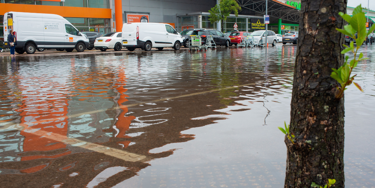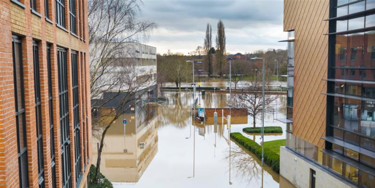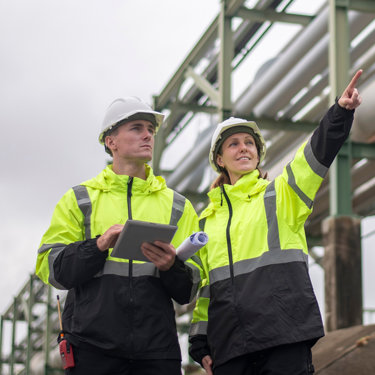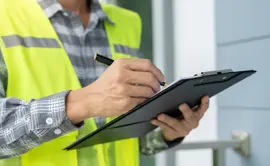What does the impact of climate change on the UK’s drainage infrastructure mean for your business?
Published: 15 November 2024
The UK's climate is changing rapidly. We're seeing more frequent and intense rainfall events, rising sea levels, and more extreme weather conditions. These changes have significant implications for our infrastructure, particularly our drainage systems.
For those responsible for large infrastructure and buildings, understanding the specific impacts of climate change on drainage is crucial. It's not just about preventing flooding; it's about ensuring the long-term resilience and operational efficiency of your buildings.

The impact of heavy rainfall on drainage infrastructure
Heavy rainfall - a feature of a changing climate - can wreak havoc on most drainage, but poorly maintained drainage infrastructure will suffer the most. When drainage systems are not regularly inspected, cleaned, and repaired, they become less effective at handling these increased water volumes.
The consequences of this can be severe:
- Flooding: overburdened drainage systems can lead to flooding, both indoors and outdoors. This can damage property, disrupt business operations, and pose health risks.
- Water damage: water ingress can cause significant damage to buildings, including structural damage, mould growth, and electrical faults.
- Erosion: heavy rainfall can erode soil and damage foundations, especially in areas with poor drainage.
Predicting future rainfall patterns
To effectively prepare for the impacts of climate change on drainage infrastructure, it's key to understand future rainfall patterns. Climate models, combined with historical data, provide valuable insights into these trends.

Key trends
Increased rainfall intensity
Climate projections indicate that the UK will experience more intense rainfall events, even if the overall annual rainfall remains similar. This means that drainage systems will need to be capable of handling higher peak flows.
Regional variations
While the entire UK will be affected, certain regions are more vulnerable. For instance, the northwest of England and Scotland are projected to experience more frequent and intense rainfall events, particularly during winter months. Conversely, some areas are anticipated to see increases in summer rainfall intensity.
More extreme changes in rainfall patterns
Seasonal changes in rainfall events can have significant impact on ground conditions. During a dry summer, soils can shrink and crack. It is more difficult for dry ground to absorb large volumes of rainwater quickly and, therefore, surface water flooding is more likely. Repeated shrinkage and swelling of soils can lead to underground services becoming damaged, including pipework, interceptors, and underground tanks. Clay soils are most at risk of shrink/swell.
The UK Climate Projections 2018 (UKCP18) provide detailed regional projections for various climate variables, including rainfall. By analysing these projections, infrastructure owners and operators can assess the potential impacts on their drainage systems and develop appropriate adaptation strategies, especially if they are in areas precited to get worse.
For example, UKCP18 suggests that by the 2080s, the UK could experience:
- Warmer, wetter winters, leading to increased river flows and potential flooding.
- Hotter, drier summers, where overall summer rainfall may decrease, intense rainfall events could still occur, leading to flash flooding.
Future-proofing your drainage infrastructure
As the climate changes, so too must our approach to drainage design. Traditional design methods may no longer be sufficient to cope with the increased frequency and intensity of extreme weather events.
Designing for a wetter future
As climate change intensifies, we can expect more frequent and heavier rainfall events. To mitigate the risks associated with increased rainfall, your drainage system must be designed to handle higher flow rates and larger volumes of water.
Key design considerations
- Oversized infrastructure: consider increasing the size of pipes, channels, and other drainage components to accommodate higher flow rates.
- Enhanced network capacity: upgrade your drainage network to handle increased water volumes, particularly in areas prone to flooding.
- Stormwater retention and attenuation: incorporate features like detention basins, infiltration trenches, and green infrastructure to slow down and capture stormwater run-off, reducing the peak flow rates and minimising the risk of flooding.
- Hydraulic modelling: utilise advanced hydraulic modelling tools to simulate the performance of your drainage system under various rainfall scenarios. This will help you identify potential bottlenecks and optimise the design.
- Material selection: choose materials that are durable, resistant to erosion, and capable of withstanding increased hydraulic loads.
- Regular maintenance: implement a robust maintenance programme to ensure your drainage system functions optimally and can respond effectively to changing conditions.
Adapting your drainage infrastructure to a changing climate
To ensure the resilience of your drainage infrastructure in the face of climate change, a proactive approach is essential, including regular inspection and maintenance. By conducting routine checks, removing debris, and repairing damage promptly, you can identify and address potential issues early on.
Upgrading your drainage system can also be beneficial. Increasing pipe diameter and installing additional drainage points can improve water dispersal. Sustainable drainage systems (SuDS) offer a more environmentally friendly approach. Green roofs, rain gardens, and permeable pavements can all help to reduce surface run-off.
Monitoring devices can be added to your underground services to detect ground movements over time, as well as leaks – so that you can act fast to remediate.
Finally, developing a robust emergency response plan is vital. This should include detailed contingency plans, essential equipment, and regular drills to ensure your business is prepared to respond effectively to flooding events.
By implementing these strategies, you can significantly enhance the resilience of your drainage infrastructure and protect your buildings from the adverse effects of climate change.

Harnessing the power of rainwater harvesting
Rainwater harvesting - the collection and storage of rainwater for later use - offers a sustainable and cost-effective solution for businesses, especially those with large roof areas, like warehouses and industrial buildings. By capturing rainwater, you can reduce reliance on water supplies, lower water bills, and minimise stormwater run-off (which can contribute to flooding).
How rainwater harvesting works
Rainwater is collected from the roof and directed into storage tanks. This water can then be used across your business for many things:
- Toilet flushing: a significant portion of water usage in commercial buildings is for toilet flushing. Rainwater can be effectively used for this purpose.
- Cleaning: rainwater can be used for cleaning floors, equipment, and vehicles.
- Irrigation: rainwater can be used to irrigate landscaping, reducing the need for treated water.
Benefits of rainwater harvesting
- Reduced water bills: by reducing reliance on supplied water, businesses can significantly lower their water bills.
- Sustainable water use: rainwater harvesting promotes sustainable water use and reduces strain on water resources.
- Flood prevention: by capturing rainwater, you can help reduce stormwater run-off and mitigate the risk of flooding.
- Improved water quality: rainwater is often cleaner than supplied water, reducing the need for water treatment.
Building a resilient future
The impacts of climate change on drainage infrastructure are undeniable. By understanding the challenges and implementing effective solutions, we can build a more resilient future.
Here are three actions for your business.
Assess the current state of your drainage system, identifying potential weaknesses and areas for improvement.
Consider factors like pipe capacity, slope, and material to determine if upgrades are necessary.
Establish a routine maintenance plan that includes:
- Regular inspections to identify and address issues early on
- Cleaning and desilting of drains and gutters to prevent blockages
- Consideration of monitoring and alarm systems
- Repair or replacement of damaged components
- Winter protection measures to ensure the system can cope with freezing temperatures
Investigate the feasibility of incorporating SuDS into your site design, such as:
- Green roofs to absorb rainwater and reduce runoff
- Rain gardens to filter and store rainwater
- Permeable pavements to allow rainwater to infiltrate the ground
- Rainwater harvesting systems to collect and reuse rainwater
Let's work together to safeguard our environment and secure a sustainable future for your business and its drainage infrastructure.
More from our Knowledge Hub
Environmental compliance today, creating a sustainable tomorrow
Helping you reduce risk to the environment and your operation by managing assets compliantly while achieving commercial, ESG, and net-zero goals.
Contact our experts




